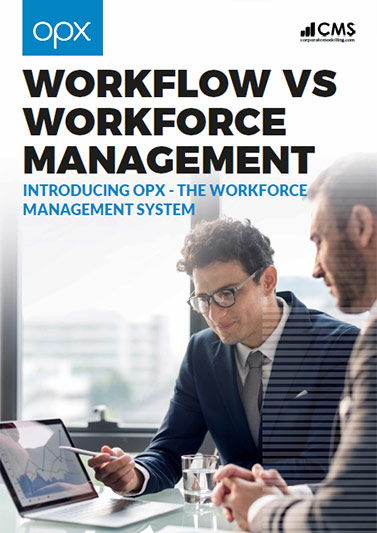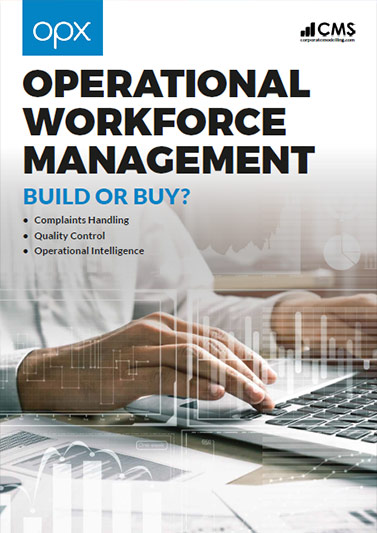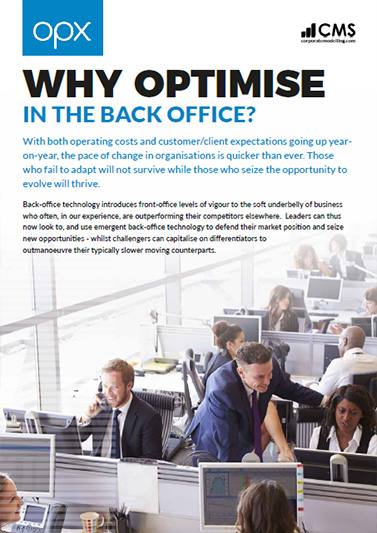Who uses OPX?
With years of experience in business process automation, we have become aware that businesses without suitable systems and controls in place have been facing similar challenges. These challenges include:
- locating business bottlenecks
- providing effective training
- lack of real-time statistics
- identifying quality issues quickly
- assigning case ownership
- relying on manual and non-integrated MI
- overviewing the benchmark achievement processes
- understanding the process risks
We addressed every one of these challenges by developing OPX.

Performance Monitoring
OPX is the right solution for every business which needs to monitor workforce productivity and performance, and identify training needs. Companies that can benefit the most from OPX implementation tend to hire resources to perform (often) repetitive tasks related to meeting a service demand.

Typical OPX Users
To help better understand what can OPX do for your business, we prepared a list of several office personas and challenges they are commonly faced with. For each challenge, we have explained how OPX can tackle it. Listed below are examples of typical OPX users. Expand each section to find out how using OPX provides benefits to each role.

OPX enables back-office agents to:
- “Get Next”- upon completion of the task, they can move on to the next task, best-suited for their skillset
- Defer, refer or escalate tasks
- Record their breaks, phone calls and meetings
- Access case history and information
- Use checklists to promote their quality and compliance
- Focus on tasks that are prioritized and suitable for their skills
| Agent Challenges | Impacts | How OPX can help |
|---|---|---|
| Managing own workload is difficult without all the information |
|
Real-time automated task allocation shifts agent focus onto the task itself.
SLA adherence is managed automatically, reducing breaches. |
| Need to balance professional development with meeting targets |
|
Reporting on quality and productivity of staff in detail, identifying specific training needs and focussing effort. |
| Risk of boredom performing monotonous tasks |
|
Splitting processes into different activities, sending mundane work to bots while keeping the decision-making steps with a human. |
| Might be asked to absorb front office work, disrupting own routine |
|
As front-office demand increases, OPX can pause work and resume as appropriate, monitoring the SLA impact throughout. |
The OPX application enables the specialist agent to:
- Accept referrals from other agents
- Use the specialist complaints module
- Receive work from a dedicated QA queue
- Automatically get new customer emails and documents
- Take ownership or share ownership of cases
- Share skills and reduce workload by developing a script flow
| Specialist’s Challenges | Impacts | How OPX can help |
|---|---|---|
| Prioritising requests from many different sources. |
|
|
| Keeping track of the many pieces of evidence and documentation associated with complex cases |
|
|
| Revisiting cases repeatedly in order to build a complex picture |
|
Flexible and optional case ownership. Enables easy monitoring of deferred cases. |
| The case queue is mixed with easy, medium, and complex cases | Spending too much time on simple cases to the detriment of more demanding cases | During peaks of workload, Scriptflow moves all of the simple cases to be handled by agents who are only trained for these specific cases |
For the Team leaders, OPX has a team leader app which enables:
- Automating routine workflow to save time
- Adjusting workflow in real-time
- Measuring staff productivity and utilization in real-time
- Managing QA teams and review work to check the quality
- Scheduling shifts and holidays, and reporting on staff attendance
- Managing agents’ skills and training
| Team Leader Challenges | Impacts | How OPX can help |
|---|---|---|
| No real-time preview on task allocation |
|
Real-time activity dashboard with archive data available. |
| Distribution of tasks according to the skillset | Even when knowing the strengths of each employee, manual task allocation takes a lot of time | Skills based workflow. Manual assignment and adjustments of tasks according to the skillset. |
| Balancing operational output with training time | Reduction in the department performance while in training | Offers quality metrics of individuals and teams, enabling Targeted training based on individual performance. |
| Making sure that the highest priority work is completed first | Without the automation of the task allocation, employees can cherry-pick cases | Sets prioritisation criteria, employees get the next task automatically. |
| Difficulty to find out which cases need the team leader’s attention | Cases can fall out of SLA and impact agent’s performance statistics without assistance |
|
For the Operations Director OPX offers the management app which enables:
- Moving staff around the organisation to maximize utilisation
- Reporting trends in utilisation and performance
- Monitoring SLA breaches and identify bottlenecks
- Reporting on performance by individual, team, or operational area
- Exploiting process automation and automated customer communication to reduce costs
- Reviewing forecasts of demand and capacity to meet it at any time against real picture
| Ops Management Challenges | Impacts | How OPX can help |
|---|---|---|
| Minimising operational costs with minimal impact on business output | Excess resource increases OpEx but removing critical resource reduces business capacity. | Utilisation reporting to ID over and under resourced teams |
| Meeting the performance benchmarks. | Lack of transparency makes it difficult to quantify the performance. | Productivity and QA metrics are available in the management board, and enable the quantifying of operational performance at all levels |
| Identifying and removing process bottlenecks | Bottlenecks cause avoidable delays and limit potential for growth. | Generation of broad range process-centric reports helps to identify and address the bottlenecks. |
| Preventing SLA breaches |
|
Default prioritisation by proximity to SLA breach. Finding and reporting breaches. |
| Adherence of the operating model | Incorrect forecasts and planning results in service degradation or missed SLA’s | OPX new forecast module forecasts demand and capacity and identified where retraining, overtime, hiring and staff reductions may be required |
OPX will support the person responsible for the business transformation with:
- Leveraging technology to allow better cost management
- Facilitating the change initiatives to move towards targeted operating model
- Managing the increasing complexity of the service portfolio
Chief Operations Officer faces another set of challenges. As a person at the top of operations they are concerned with regulatory compliance and quality delivered. OPX can help COO with:
- Managing conduct and operational risk, including regulatory compliance and complexity management strategies
- Setting the operating strategy and directing transformation,
- Quality adherence, and aiming at reducing the loss ratio.
Human Resources also can find OPX helpful. It will support the Chief Human Resources Offices with their decision by providing data on:
- Performance/Value for money from resources
- Skill levels of current resources
Hybrid working and work ethic practices.
Data and reports produced in OPX can support the work of Chief Finance Officer with:
- Setting strategies to reduce the cost,
- Managing financial and compliance risk
- Maximising and maintaining growth momentum
OPX will provide real-time data that will support CEO with ideas and decisions on:
- Strategic direction of company
- Growth in uncertain times
- Regulatory compliance
- Risk management
- Planning


 Thank you for your interest in our whitepaper. You can download Meet Our Email Bot by clicking the button below.
Thank you for your interest in our whitepaper. You can download Meet Our Email Bot by clicking the button below. Thank you for your interest in our whitepaper. You can download Why Now is the Time to Invest in Back Office Workforce Optimisation by clicking the button below.
Thank you for your interest in our whitepaper. You can download Why Now is the Time to Invest in Back Office Workforce Optimisation by clicking the button below. Thank you for your interest in our whitepaper. You can download AI Driven Forecasting for WFM & WFO by clicking the button below.
Thank you for your interest in our whitepaper. You can download AI Driven Forecasting for WFM & WFO by clicking the button below. Thank you for your interest in our whitepaper. You can download Workforce Optimisation vs Workforce Management by clicking the button below.
Thank you for your interest in our whitepaper. You can download Workforce Optimisation vs Workforce Management by clicking the button below. Thank you for your interest in our case study. You can download the HCL IBS Case Study by clicking the button below.
Thank you for your interest in our case study. You can download the HCL IBS Case Study by clicking the button below. Thank you for your interest in our case study. You can download the ReAssure Case Study by clicking the button below.
Thank you for your interest in our case study. You can download the ReAssure Case Study by clicking the button below. Thank you for your interest in our case study. You can download the Student Loans Case Study by clicking the button below.
Thank you for your interest in our case study. You can download the Student Loans Case Study by clicking the button below. Thank you for your interest in our case study. You can download the Principality Building Society Case Study by clicking the button below.
Thank you for your interest in our case study. You can download the Principality Building Society Case Study by clicking the button below. Thank you for your interest in our whitepaper. You can download WorkFlow vs WorkForce Management by clicking the button below.
Thank you for your interest in our whitepaper. You can download WorkFlow vs WorkForce Management by clicking the button below. Thank you for your interest in our whitepaper. You can download Homeworking in Financial Services Operations by clicking the button below.
Thank you for your interest in our whitepaper. You can download Homeworking in Financial Services Operations by clicking the button below. Thank you for your interest in our whitepaper. You can download Workforce Optimisation for the Back Office by clicking the button below.
Thank you for your interest in our whitepaper. You can download Workforce Optimisation for the Back Office by clicking the button below. Thank you for your interest in our whitepaper. You can download Operational Workforce Management: Build or Buy? by clicking the button below.
Thank you for your interest in our whitepaper. You can download Operational Workforce Management: Build or Buy? by clicking the button below. Thank you for your interest in our whitepaper. You can download Homeworking & Back Office Workforce Optimisation by clicking the button below.
Thank you for your interest in our whitepaper. You can download Homeworking & Back Office Workforce Optimisation by clicking the button below. Thank you for your interest in our whitepaper. You can download Why Optimise in the Back Office? by clicking the button below.
Thank you for your interest in our whitepaper. You can download Why Optimise in the Back Office? by clicking the button below.